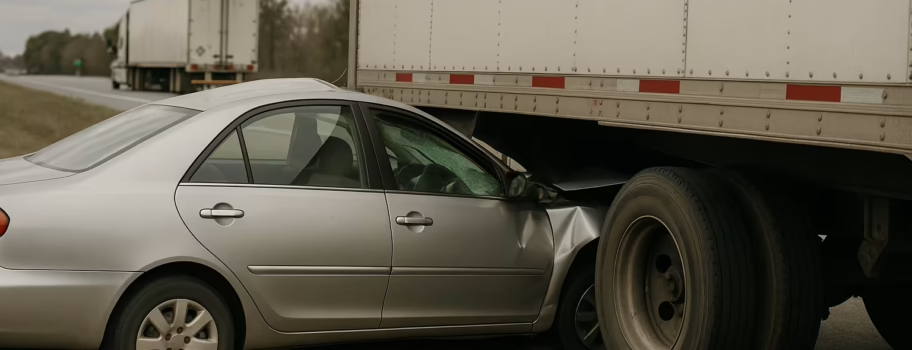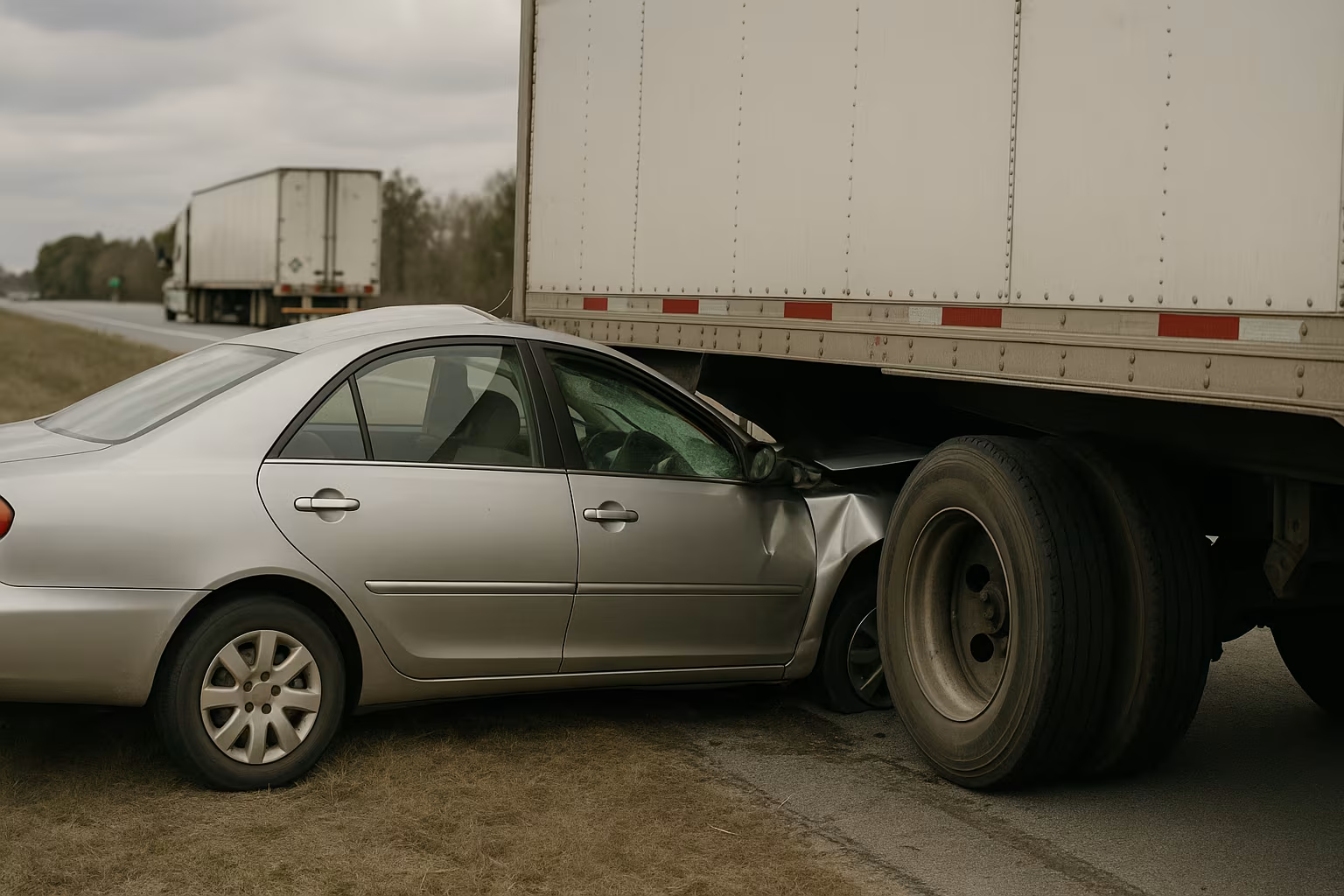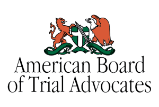Legal Rights for Underride and Override Truck Accident Victims in Texas
Underride and override truck accidents have the highest fatality rates on Texas roads, often resulting in severe injuries or death.
These accidents occur when passenger vehicles either slide underneath truck trailers (underride) or get crushed when trucks ride over smaller vehicles (override).
In Texas, victims of these crashes have legal rights to compensation, but navigating the complex liability issues requires understanding who can be held responsible and what damages are available.
At Angel Reyes & Associates, we’ve handled numerous underride and override accident cases throughout Texas.
These crashes involve multiple liable parties, from truck drivers and trucking companies to equipment manufacturers, making experienced legal representation essential for securing maximum compensation.
What Are Underride and Override Truck Accidents in Texas?
These are the deadliest types of truck accidents, involving physics that make survival difficult when 4,000-pound cars collide with 80,000-pound trucks.
The difference between underride and override crashes lies in the direction of impact and the resulting injury patterns, but both create devastating consequences for victims and families.
Understanding Underride Crashes
Underride accidents occur when a smaller vehicle slides underneath a truck trailer, causing devastating roof damage and severe head injuries.
The car essentially becomes trapped under the trailer while the truck continues moving forward, shearing off the vehicle’s roof and creating severe head and spinal cord injuries.
How Override Accidents Happen
Override accidents happen when a large truck drives over a smaller vehicle, crushing the passenger compartment with the truck’s massive weight.
These crashes typically occur when trucks cannot stop in time and literally drive over stopped or slower-moving vehicles, resulting in crushing injuries when the truck’s weight collapses the passenger compartment.
Why These Crashes Are So Deadly
The physics involved make these crashes particularly deadly.
When a 4,000-pound passenger car collides with an 80,000-pound commercial truck, the smaller vehicle absorbs almost all the impact energy.
Texas highways see these accidents frequently due to heavy commercial traffic and construction zones.
Interstate 35, which runs through Dallas, experiences regular underride and override crashes, particularly in areas where traffic patterns change suddenly or construction creates unexpected slowdowns.
Common Causes of Underride and Override Truck Accidents in Texas
Most of these devastating accidents result from preventable safety failures, with missing safety equipment and driver negligence being the leading factors.
Understanding these causes helps establish liability and strengthens your legal case when seeking compensation.
Equipment Failures That Cause Fatal Crashes
Missing or defective underride guards are the leading cause, as federal law only requires rear guards while side guards remain optional.
Many trucks operate with underride guards that meet minimum federal standards but fail in real-world crash conditions.
The current federal requirements were established decades ago and haven’t kept pace with modern vehicle safety technology.
The most common equipment failures include missing or defective underride guards, brake system malfunctions, and safety equipment that fails federal standards.
Side underride guards remain optional under federal law despite their proven effectiveness in preventing lateral crashes.
Dangerous Driver Behaviors
Truck drivers following too closely create dangerous situations on busy highways like I-35 and I-635, where sudden traffic slowdowns are common.
Distracted driving, whether from mobile phones, GPS systems, or other devices, reduces reaction time when traffic suddenly slows.
Fatigued truck drivers who violate federal Hours of Service regulations often lack the alertness needed to avoid emergency situations.
Environmental and Road Conditions
Construction zones present particular risks, as trucks need much longer stopping distances than passenger vehicles when traffic suddenly stops.
Weather and road conditions in Texas create additional hazards – sudden thunderstorms can reduce visibility and make roads slippery, while construction zones force traffic into narrow lanes with little room for error.
Who Can Be Held Liable in Texas Underride and Override Cases?
Unlike typical car accidents, these crashes often involve multiple responsible parties, which can significantly increase your potential compensation sources.
Identifying all liable parties requires thorough investigation and understanding of both federal trucking regulations and Texas liability laws.
Truck Driver Liability
Truck drivers can be held liable for negligent driving behaviors that contribute to these severe crashes.
Common violations include speeding, tailgating, or distracted driving, as well as violating federal regulations such as Hours of Service limits.
Drivers who operate under the influence of alcohol, drugs, or prescription medications face significant liability, as do those who fail to maintain safe distances required for large commercial vehicles.
Trucking Company Responsibility
Trucking companies may bear responsibility through various forms of negligence that put dangerous drivers and equipment on the road.
This includes negligent hiring practices that put dangerous drivers on the road and inadequate training on safe driving and emergency procedures.
Companies also face liability for poor vehicle maintenance that leads to brake or equipment failures, as well as pressuring drivers to meet unrealistic delivery schedules that encourage unsafe driving.
Manufacturer and Parts Supplier Liability
Manufacturers and parts suppliers can be liable when safety equipment fails during crashes.
This includes underride guards that fail due to design defects or poor manufacturing, brake systems that malfunction because of defective components, and safety equipment that fails to meet federal standards during real-world crashes.
Government Entity Liability
Sometimes liability extends to government entities for dangerous road conditions. This includes poor road design that creates dangerous merging situations, inadequate signage in construction zones, and failure to maintain safe road surfaces and barriers.
Evidence that can support your claim includes driver logbooks and Hours of Service violations, vehicle maintenance and inspection records, underride guard testing and failure documentation, and witness statements and traffic camera footage.
What Compensation Can Victims Pursue in Texas?
The severe nature of underride and override accidents often justifies substantial compensation across multiple categories. Texas law allows victims to seek both economic and non-economic damages, with no caps on most personal injury awards.
Medical Expenses and Future Care
Medical costs in these cases often reach hundreds of thousands or even millions of dollars. Emergency treatment for head trauma, spinal cord injuries, and crushing injuries requires specialized care at major trauma centers.
Compensation covers emergency trauma surgery and extended hospital stays, long-term rehabilitation services including physical, occupational, and speech therapy, ongoing medical care that may be required for the rest of victims’ lives, and psychological counseling for emotional trauma.
Lost Income and Earning Capacity
Lost income calculations become complex when victims suffer permanent disabilities.
Economic experts must evaluate multiple factors including current lost wages and employment benefits, future earning potential and career advancement opportunities, impact of permanent disabilities on long-term employment, and loss of retirement contributions and health insurance benefits.
Pain and Suffering Damages
Pain and suffering damages address the non-economic impacts of these severe injuries. Texas law doesn’t cap these damages in most personal injury cases, allowing awards to reflect the true extent of victim suffering.
This includes chronic pain and permanent disabilities, emotional trauma and loss of life enjoyment, permanent disfigurement and scarring, and impact on family relationships and daily activities.
Wrongful Death Benefits
When accidents prove fatal, families can pursue wrongful death damages including funeral and burial expenses, loss of financial support the deceased would have provided, loss of companionship and guidance, and mental anguish caused by the loss.
How Texas Comparative Negligence Affects Your Claim
Understanding Texas fault laws protects your claim’s value and helps counter insurance company tactics designed to reduce or deny compensation. Texas follows modified comparative negligence rules that can significantly impact your recovery.
Texas Comparative Fault Rules
Texas follows modified comparative negligence, which means you can recover damages if you’re less than 51% at fault, your compensation gets reduced by your fault percentage, and if you’re 51% or more at fault, you cannot recover anything.
Common Insurance Company Tactics
Insurance companies often try to blame victims to reduce claim values by claiming you were speeding or driving recklessly before the crash, arguing you failed to maintain proper lookout for the truck, suggesting your vehicle contributed to the accident through poor maintenance, and claiming you didn’t take evasive action to avoid the collision.
How Experienced Attorneys Counter These Tactics
Experienced attorneys counter these tactics by gathering evidence that supports your version of events, working with accident reconstruction experts to establish accurate fault, challenging insurance investigations that unfairly blame victims, and negotiating based on real fault percentages, not insurance company spin.
Pro Tip: Never admit fault or accept blame after these accidents. Insurance adjusters will contact you quickly, often while you’re still hospitalized, and try to get recorded statements that can be used against you later.
Safety Regulations and Industry Standards
Current federal regulations have major gaps that contribute to these deadly accidents, and understanding these shortcomings helps establish when companies and manufacturers fail to protect the public.
Current Federal Requirements
Federal regulations require specific safety measures, but enforcement and standards often fall short.
These include rear underride guards on trailers manufactured after 1998, specific strength standards for crash protection, and regular inspection and maintenance of safety equipment.
Major Problems with Current Standards
Despite federal rules, significant problems remain.
Side underride guards aren’t required under federal law, current rear guard standards often fail in real-world crashes, enforcement is inconsistent across different jurisdictions, and older trailers may lack modern safety equipment.
Industry Resistance to Safety Improvements
The trucking industry has resisted many safety improvements, citing costs and implementation challenges.
This includes mandatory side guards to prevent lateral underride crashes, stronger rear guard standards that better protect vehicle occupants, advanced braking systems to reduce stopping distances, and better visibility equipment including improved lighting and reflective materials.
When companies violate safety standards or use substandard equipment, it strengthens negligence claims and may support punitive damages.
Why Experienced Legal Representation Matters
Underride and override cases involve complex technical and legal issues that require specialized knowledge and resources that most attorneys don’t possess. These cases demand immediate action to preserve evidence and protect your rights.
Time-Sensitive Evidence That Disappears Quickly
Critical evidence includes accident scene preservation before cleanup occurs, vehicle inspection to document safety equipment failures, driver records including logbooks and drug test results, and company maintenance files showing negligent practices.
Complex Technical and Legal Issues
These cases demand understanding of federal trucking regulations and safety standards, vehicle engineering and underride guard effectiveness, accident reconstruction to determine exactly what happened, and medical complexities of severe injury treatment.
What You’re Up Against
Trucking companies and manufacturers have teams of experienced defense attorneys, safety experts who minimize equipment failures, insurance adjusters trained to reduce claim values, and corporate resources to fight cases aggressively.
How Angel Reyes & Associates Levels the Playing Field
At Angel Reyes & Associates, we level the playing field with 30+ years of experience handling complex truck accident cases, our own team of experts and accident reconstruction specialists, comprehensive investigation of every aspect of your crash, and aggressive negotiation with insurance companies.
We offer no upfront costs, you only pay if we win, and we provide personalized legal guidance every step of the way.
You pay nothing unless we win your case, and we handle all aspects of your claim while you focus on recovery.
What Should You Do After an Underride or Override Crash?
Protecting your health and legal rights requires immediate action, as these crashes often cause internal injuries that aren’t immediately apparent and evidence disappears quickly.
Immediate Medical and Safety Steps
Get emergency medical care immediately – these crashes often cause internal injuries that aren’t immediately apparent. Prompt medical attention saves lives and creates crucial documentation for your legal case.
Evidence Preservation at the Scene
If you’re able, document everything possible by photographing all vehicles and damage patterns, documenting underride guard conditions, collecting truck company and DOT information, and getting witness contact information.
Protecting Your Legal Rights
Avoid discussing fault with anyone except police officers. Insurance adjusters will contact you quickly, so stick to basic facts and avoid speculating about what caused the crash.
Texas Underride/Override Crash Checklist:
- Get emergency medical care immediately
- Document all vehicles and damage patterns
- Photograph underride guard conditions
- Collect truck company and DOT information
- Contact Angel Reyes & Associates
Why Immediate Legal Help Matters
Contact experienced legal help immediately. Underride and override cases require specialized knowledge, so don’t try to handle these complex claims alone.
Time matters critically in preserving evidence and protecting your rights.
Frequently Asked Questions About Underride and Override Accidents
What’s the difference between underride and override accidents?
Underride accidents occur when smaller vehicles slide under truck trailers, causing roof shearing and severe head injuries. Override accidents happen when trucks drive over smaller vehicles, causing crushing injuries from the truck’s weight.
Are underride guards required on all trucks?
Federal law requires rear underride guards on trailers manufactured after 1998, but side guards aren’t mandatory. Many existing guards fail to meet real-world crash protection standards.
Who can be held liable in these types of crashes?
Multiple parties may be responsible including truck drivers, trucking companies, underride guard manufacturers, and sometimes government entities responsible for road design or maintenance.
What compensation is available for families?
Victims can seek medical expenses, lost income, pain and suffering, and property damage. In fatal cases, families may pursue wrongful death damages including funeral costs and loss of companionship.
How does Texas comparative fault law affect these cases?
If you’re less than 51% at fault, you can still recover damages, but your compensation gets reduced by your fault percentage. Insurance companies often try to unfairly shift blame to victims.













